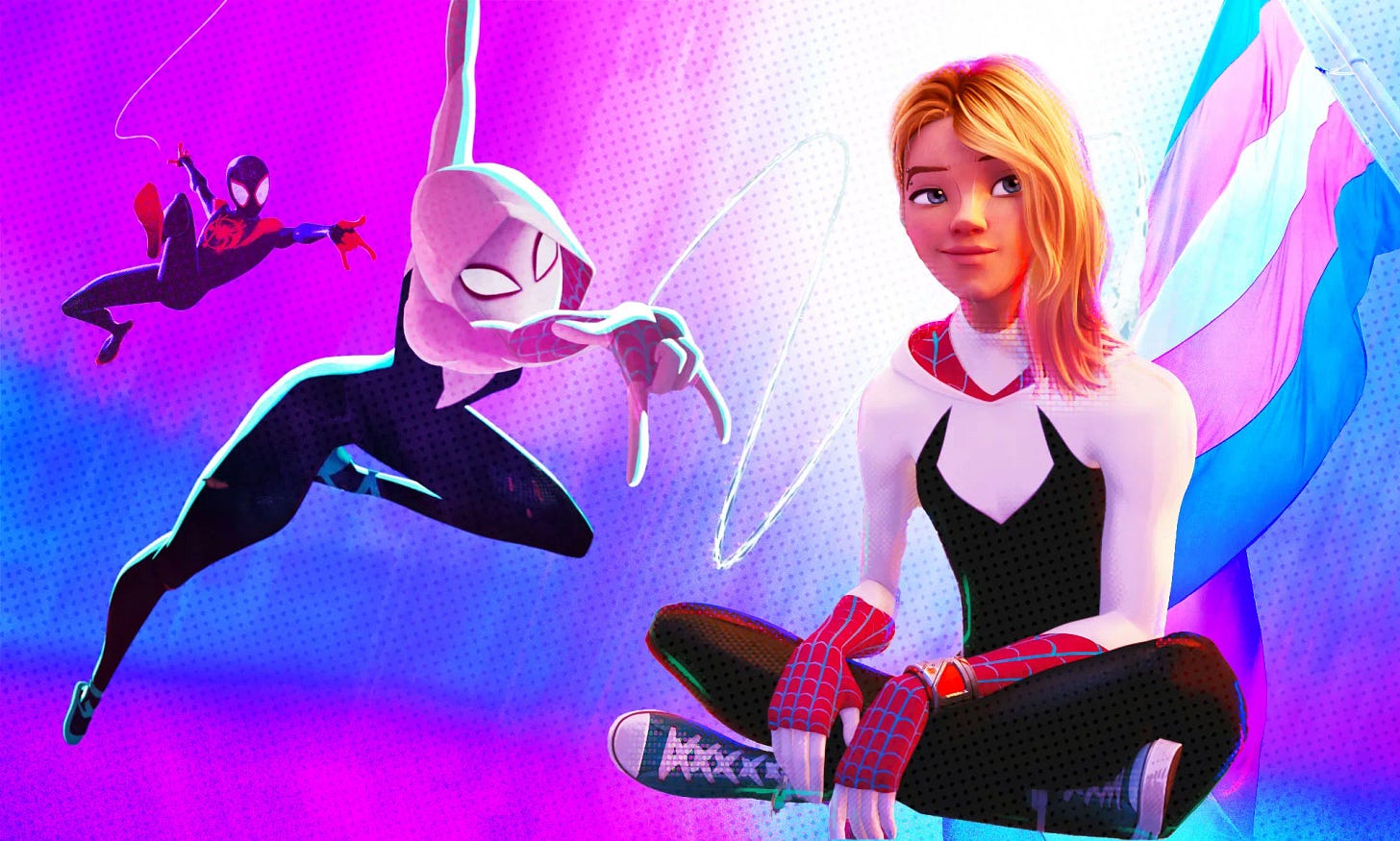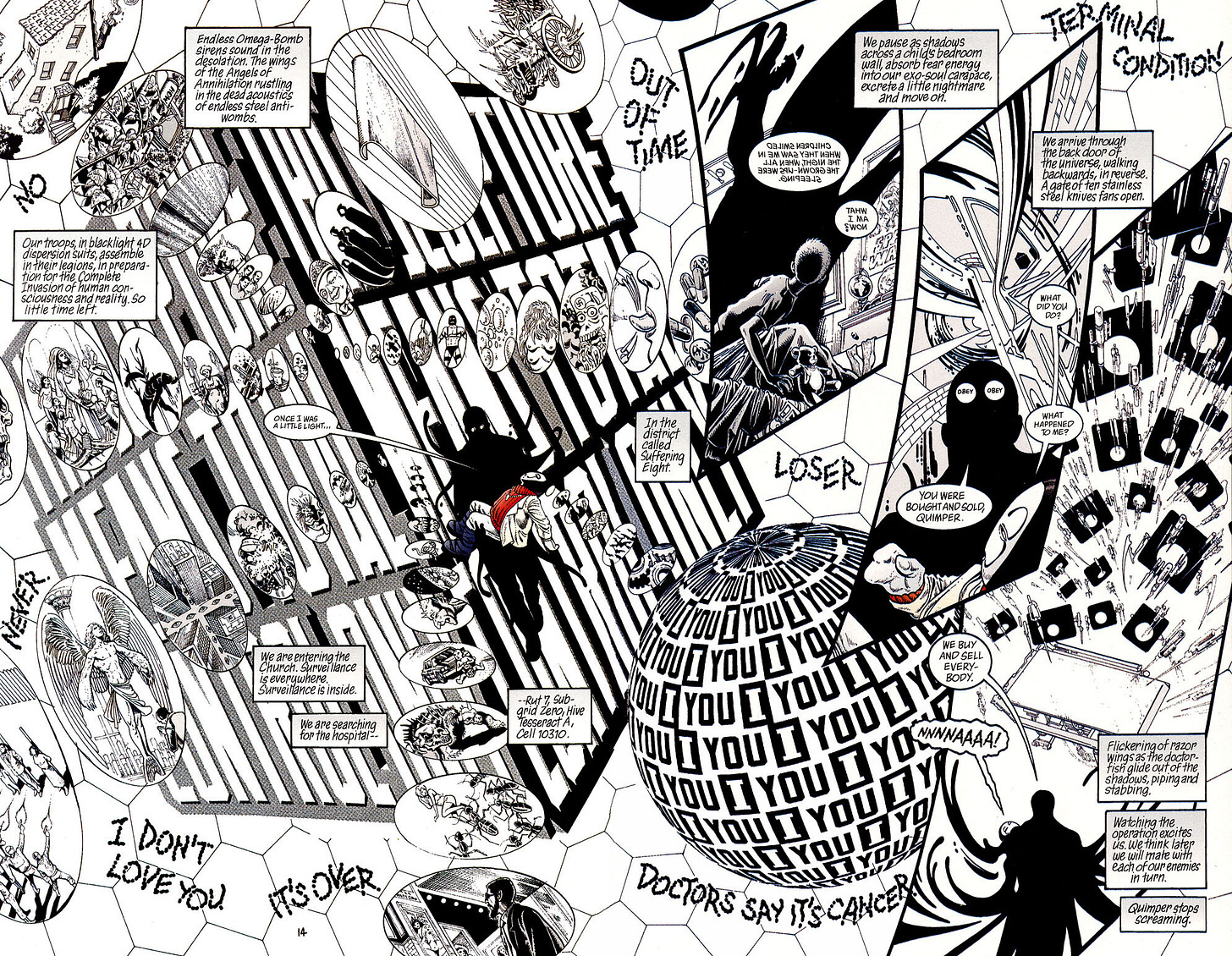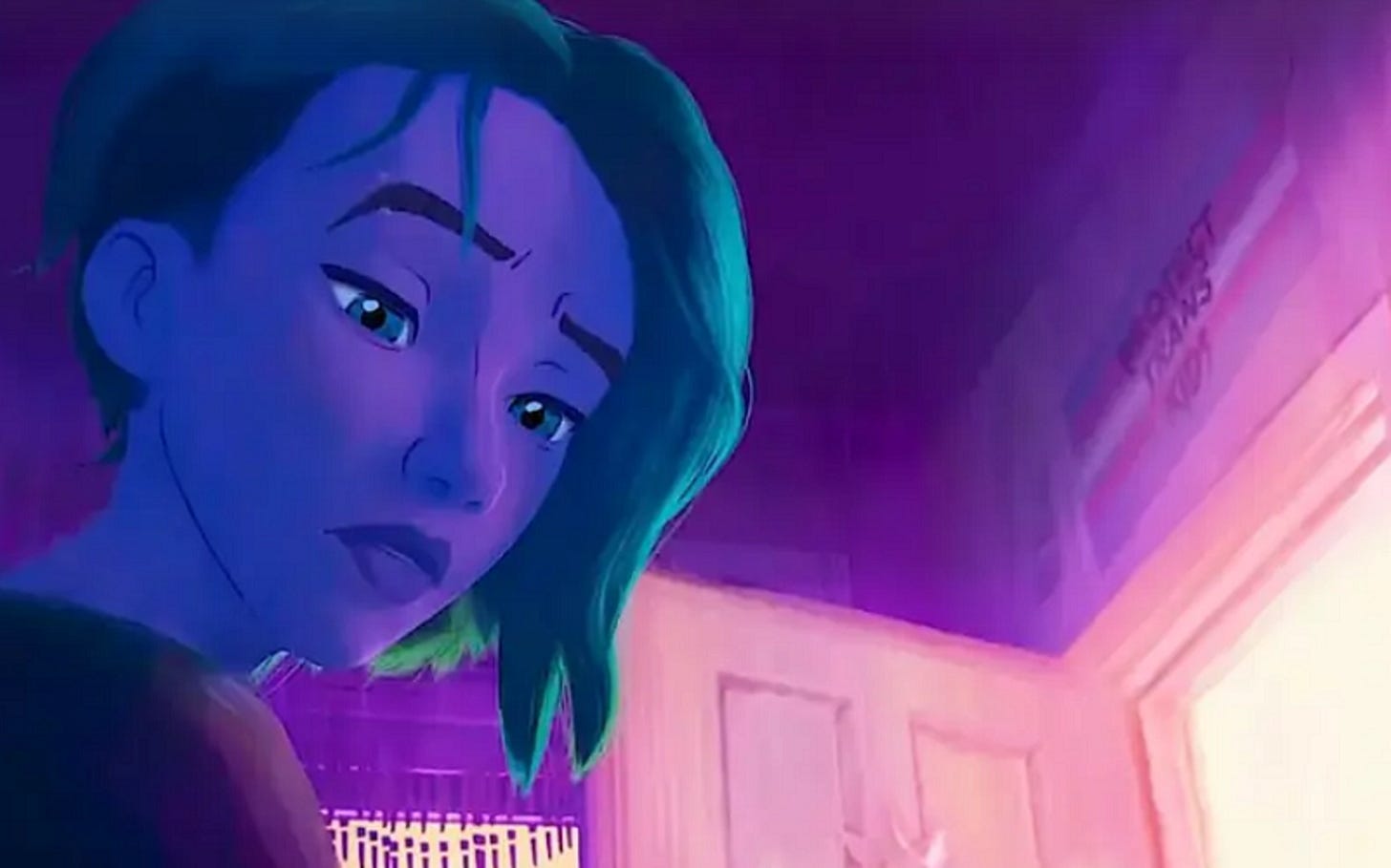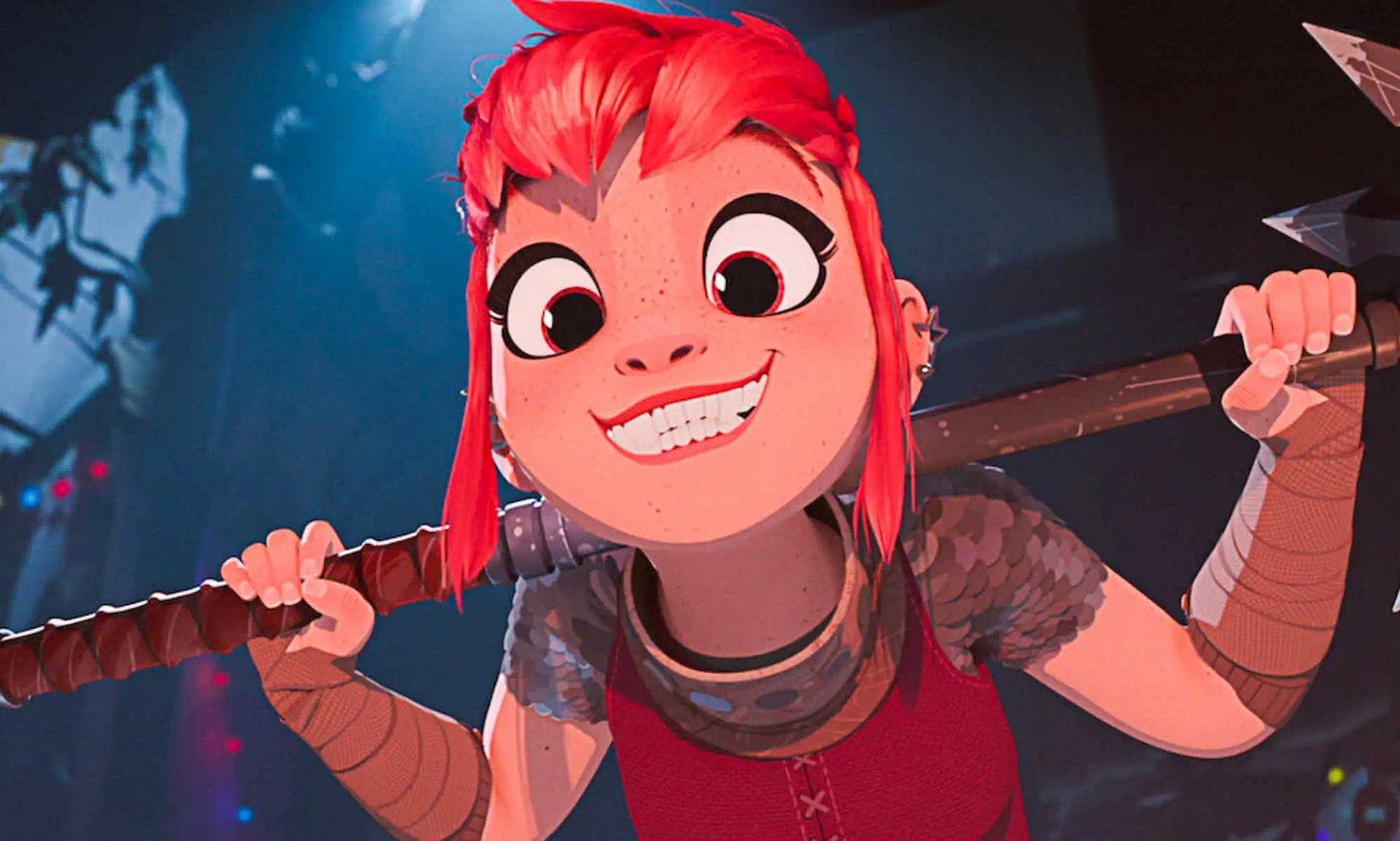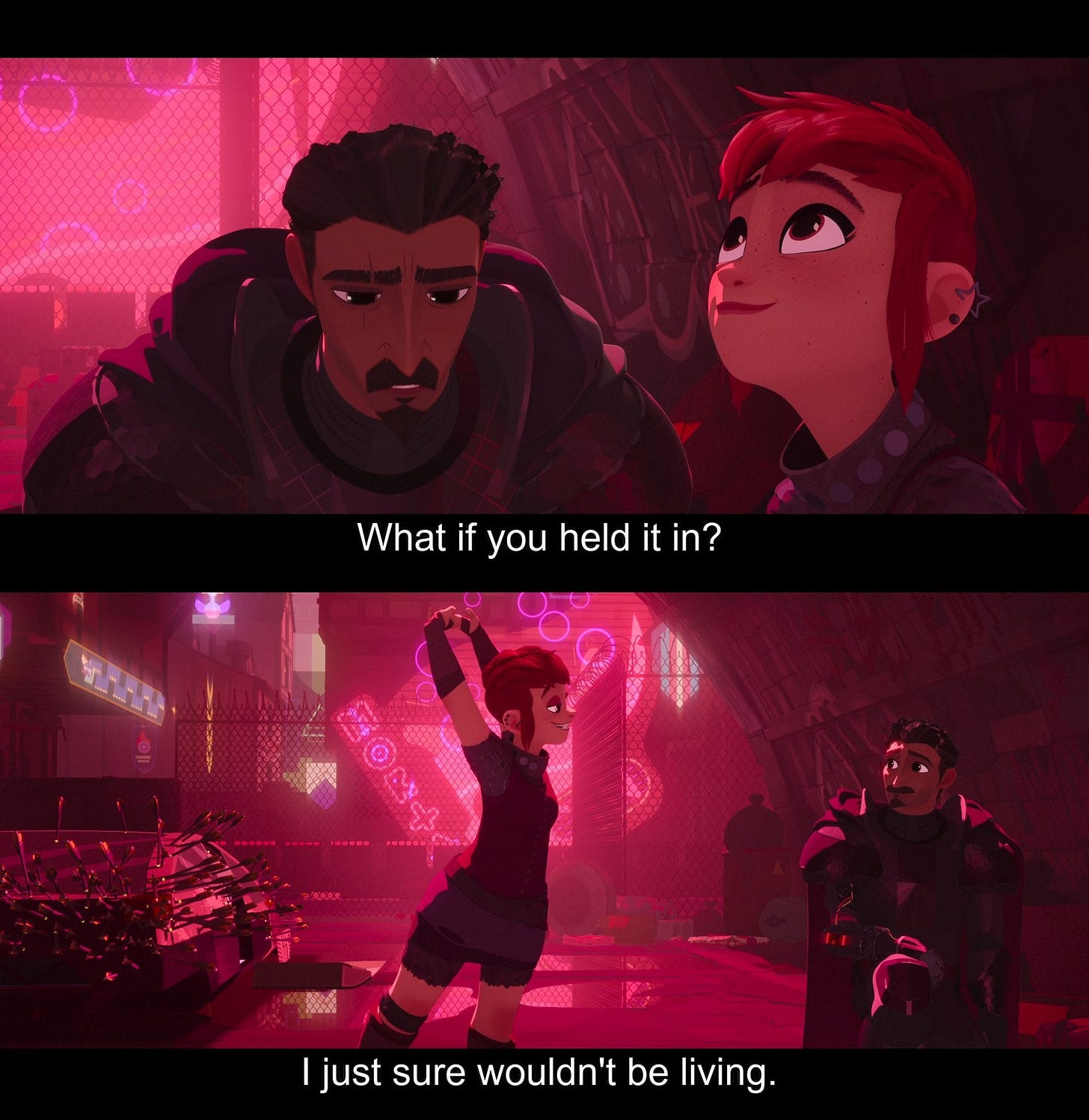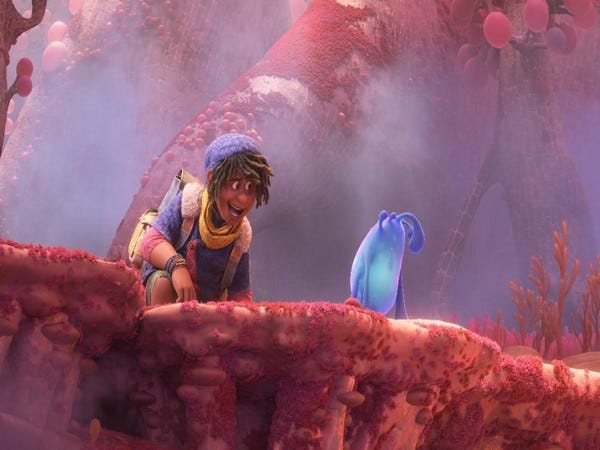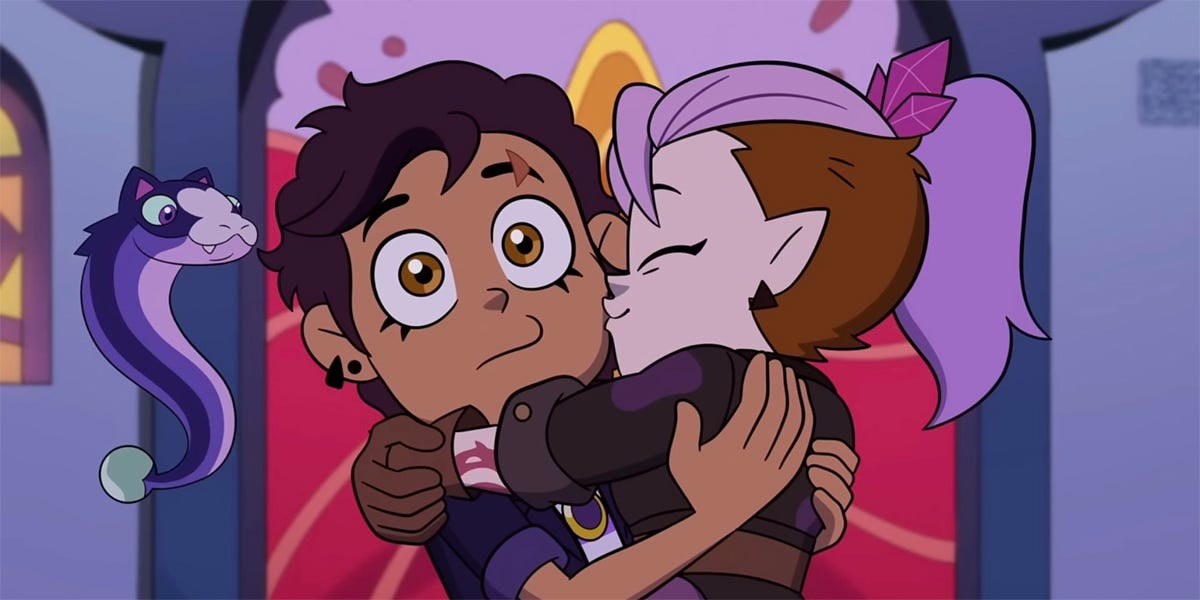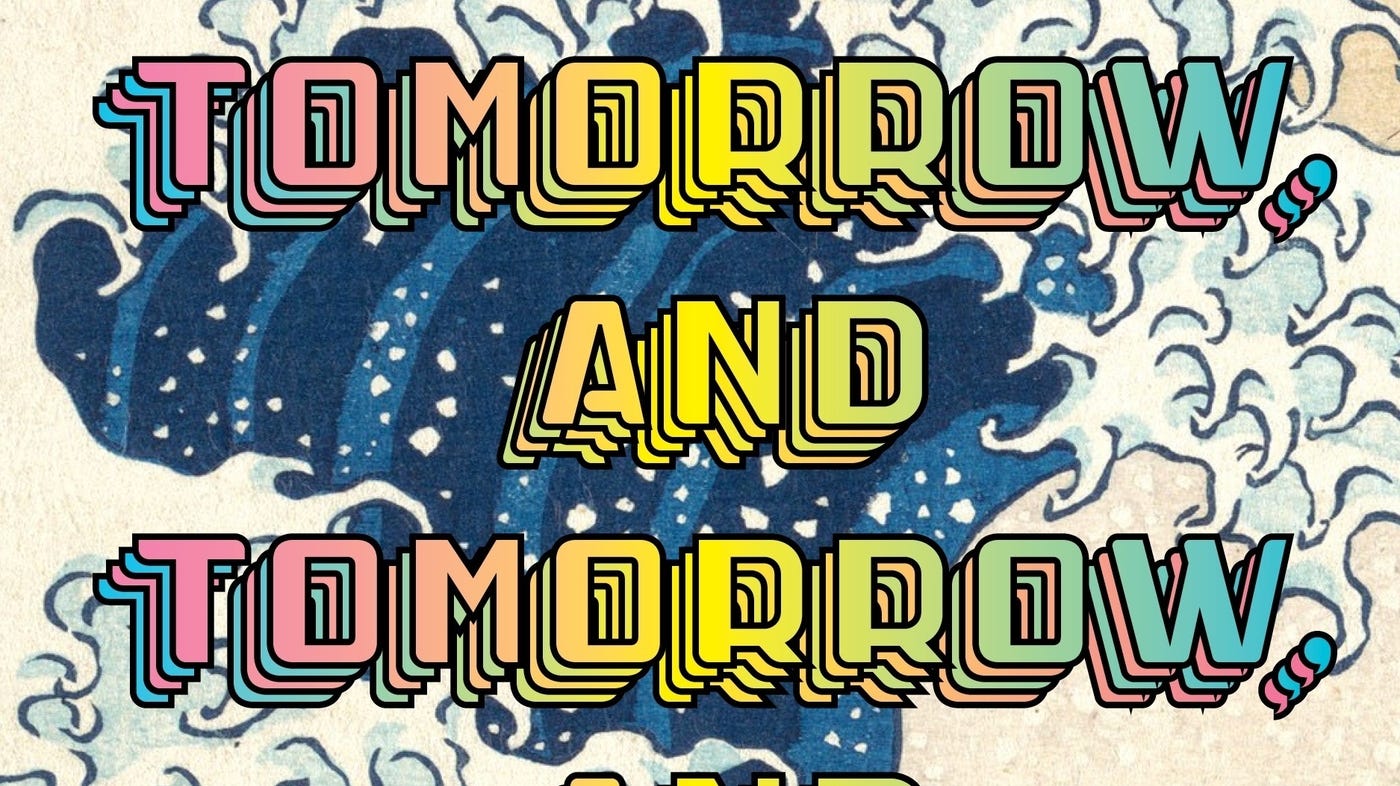We need to talk about Gwen… and Nimona... and Luz...
With major films and series bringing rounded, respectful trans representation to younger audiences, while appealing to parents too, could 2023 be "The Transgender Tipping Point: the Next Generation"?
Now, before you yawn and say “We know, we know… the most recent Spiderman, Nimona, Strange World, Owl House, etc. are all massively queer-coded, what do you take us for?!” I need to hastily point out that this isn’t (just) going to be an exegesis of some pretty in-your-face trans representation (in my mind’s eye is Abigail Thorn’s mocking expression as she realizes she’s just done a Jordan Peterson by spotting a supposedly archetypal pattern and claiming it proves something about human nature). No, I want to start by drilling into the facts and figures behind all the claims of controversy - or of critical success and box office failure as less-LGBT friendly countries reject “the woke agenda to corrupt our kids!” - that seem to accompany so many recent animated films and series. I’ll move on to consider Why Now, at this point in cultural history, and then whether the allegories are legible to the (larger) cis-het audience, and whether the normalization of overtly queer characters might be more significant, even when their appearance barely merits a B-story with its own narrative arc and character development.
First up, then, is Spiderman: Across the Spider-Verse (2023), in which the B-story (tightly woven into the A-) is a classic “will they / won’t they?” between Miles Morales and Gwen Stacey AKA Ghost Spider, although every queer viewer on the planet is probably more concerned with the question “will she / won’t she reveal her AGAB (which isn’t even up for debate), and they still get together?!” The figures give us a strong indication a queer love-story need not be box-office poison but also hint at the size of the global audience who now consciously or unconsciously equate trans flag colours with kick-ass heroism:
At the global box office, Across the Spider-Verse accomplished an astonishing feat by surpassing the impressive milestone of $400 million in a mere two weeks after its release. […] This outstanding performance resulted in a phenomenal global haul of $405 million.
https://collider.com/spider-man-across-the-spider-verse-box-office-breakdown/
It’s too early to discuss award nominations for Across (Huh! – the English word for “trans” – just spotted that…) but Into the Spider-Verse (2018) picked up the Best Animated Feature Oscar, an award from the African-American Film Critics Association given the prominence of Miles, another from the Alliance of Women Film Journalists (Gwen being an excellent supporting character albeit with no obvious trans coding as yet), and seven Annies. Its gross was $375 million and its Rotten Tomatoes aggregator: 97%. In short, Across surpassed its predecessor in two weeks and I’d bank on it doing even better with awards committees as the already spectacular graphics kicked up a gear. Briefly: different visual styles are used in both films for individual characters, not just diegetic levels (as in, say, Ghibli’s neglected masterpiece Pom Poko), tacitly reflecting the endless variance of culture, ethnicity, gender, and sexuality, even if the explanation within the narrative itself is that the characters have come from across the multi-verse (here: “spider-verse”, which implies the interconnectedness and interdependence of all people, however diverse, rather than merely parallel time-streams as in older Marvel plot devices to allow characters to be resurrected, sometimes rather cynically). Incidentally, while I haven’t dug into the animators’ stated influences, the polymorphous visual style for me recalls Grant Morrison’s graphic novel series Doom Patrol and The Invisibles in the 90s, which certainly did influence cinema’s best known trans allegory The Matrix (1999). (That’s Grant Morrison, the first CBE to be out as an NB, by the way.)
I’m itching to reel off a detailed account of everything that makes Across an instant trans classic and – no hyperbole – the most moving, empowering trans representation I’ve ever seen in my long life of watching films where trans people are mocked, sexualized, fridged, and psychopathologized; I genuinely believe its long reach will have a significant impact on the attitudes of a generation. Yes, I was almost exactly a year into HRT when I watched it with high levels of both E and T, but that’s hardly the sole reason I’d never cried so much, so quickly, and so often throughout any film in my life. Lucky I had what my son calls my “scruffy bob” covering my face so he and his friend sitting next to me couldn’t see this in the cinema…
The film’s trans elements are covered quite comprehensively here: https://www.vox.com/culture/2023/6/7/23752735/across-the-spider-verse-gwen-stacy-transgender# although the big ones would be the trans colours rendered in ultra vivid neon used in almost every frame where it’s just Gwen… the Protect Trans Kids poster on her bedroom wall… the (possible) trans badge worn by her cop dad (who might have worn a Progress badge as an everyday ally but the trans badge is way too specific not to imply a trans kid in the family). There’s some nice wordplay too: “Spiderman!” shouts a villain. “Which one? Him, him, or me?” replies the female-presenting-but-AMAB Gwen. As a dubious metric for what this means to trans people, my Reddit post about watching the film got 25,000 views without a cute meme or image (which might merit ten times that), although anecdotally a cis-het colleague of similar age said he picked up on none of it – not even the fact that about a third of the film uses a trans palette of colours. Nonetheless (segue!) he did recommend me…
…Nimona! As one blogger wrote: ‘Nimona is a shapeshifter, which is an incredible way to have a character who exists in the queer space as being fluid in gender and sexuality, something which I personally LOVE to see as a non-binary person myself.’ https://greenlightcomics.com/review/nimona-by-nd-stevenson/. If it weren’t for the other main character having been in an unambiguously gay relationship we know about from the first three minutes of the film, a cis-het audience might not have picked up on this coding but what’s most surprising – and I can’t think of an equivalent in any animated film – is what I call “the dysphoria scene” where Nimona articulates one of the aspects of trans experience of which cis people are often most oblivious:
(Ballister removes an arrow from Nimona's thigh)
B: "Most people scream at that part."
Nimona: "I'm not a people"
B: "Don't you feel anything?"
N: "I feel worse when I don't do it. I feel itchy inside. It feels like the second before you sneeze. And then I shape-shift...and I'm free."
B: "What if you held it in?"
N: "I'd die. "
B: "That's horrible!"
N: "I wouldn't die-die, but I just sure wouldn't be living"
Across still packs more of a punch overall, and does that classic trope of all superhero movies – the coming-out / unmasking scene – brilliantly, but it doesn't try to articulate dysphoria quite so directly. Given the range of sexualities, and the different ethnic and socio-economic backgrounds of the characters, an entire article could be written about the film’s exploration of intersectionality, and the relative degrees of acceptance of different groups, e.g. cis gay male relationships: almost entirely accepted and passing without comment, even among the elite… upwardly mobile ethnic minorities: more suspicion… trans people: monsters. Nimona herself articulates the way that values are transmitted: “Little kids grow up thinking they can become a hero by running a sword through the heart of anything different.” This is barely even a metaphor for transphobic violence – more like a statement of fact – when you recall the stabbing of trans teen Brianna Ghey in February by fellow teens, which left me more emotionally devastated, for weeks, than any murder I can think of, and still drives much of my fervour about trans issues. Nonetheless, watching Nimona with my own kids beside me, my overwhelming emotions were love and hope for them and gratitude that a generation will grow up to love this film. Yes, there’s so much hatred for us now but there’s more understanding & visibility than at any time before. Returning to the metrics, then, just how much visibility has it granted us?
Nimona […] has added another critically acclaimed animated movie to [Netflix]’s list of past successes. […] The movie landed itself an impressive 93% rating on Rotten Tomatoes from both audiences and critics, and […] has become an instant hit for Netflix, who will be taking this as a win over Disney. [C]ritics scor[ed] it around 76%, audiences being much more generous with a 92% rating, but the box office gross after two weeks [was] $70 million adrift of its huge $200 million budget. Following last year’s disastrous release of Strange World, which took only $73 million worldwide, Nimona’s success on Netflix will be a big kick for Disney considering it was a movie that they could have made. https://movieweb.com/nimona-netflix-93-rotten-tomatoes-rejected-disney-lgbtq/.
Strange World (2022), in case you missed the (exaggerated) coverage of its weak reception ‘…explores a fantastical environment full of mysterious creatures and flora, including flying fish and walking rock columns, [and] also includes a first for Walt Disney Animation Studios: a gay teen romance. The animated feature introduces viewers to Ethan Clade, a biracial, openly gay teenager.’ https://variety.com/2022/film/news/strange-world-gay-biracial-character-jaboukie-young-white-1235432785/ Incidentally, the various articles I’ve quoted tend to be euphemistic about the reasons for the varying degrees of success of these films, but the one in Variety is the most direct: “Strange World Cast and Creators on the Disney Film’s Biracial, LGBTQ Character: ‘You Don’t Have to Normalize Normal. It Just Is’.” Coverage at the time crowed about the comparable fate of the Toy Story spin-off about Buzz Lightyear, implying that Disney’s attempt to “pursue a woke agenda” (scare quotes not actual quotes) was a failure it would soon regret, e.g.
Like many films these days, Lightyear was not without its fair share of controversy, with many audiences boycotting the film, and some countries even banning it, due to a scene involving a same-sex kiss. As such, sadly, the Buzz Lightyear film never off to a good start. https://insidethemagic.net/2023/02/buzz-lightyear-film-director-box-office-dr1/
Note ‘…a scene…’. Other critics pointed out that the whole thing was just rather dry, a bit melancholy, and completely reinvented the character from Toy Story, who was always a bit feckless and only worked as a foil to smarter ones. If Disney chickened out of subsequent animations because it connected a lack of runaway success with a same-sex relationship in the background (barely a B-story) that’s disappointing but so-so storytelling was probably more important. What we have to remember is that ‘the arc of the moral universe is long but it bends toward justice’ (MLK); there is simply far more representation of queer characters in prominent roles in animations for younger viewers than there was five years ago. Do some movies fail to turn a profit and some series get cancelled? Yes, but then the market is pretty brutal with so many studios demanding revenue over $100 million to guarantee a second instalment or second season.
Only weeks after declaring “I want to be Nimona! She’s so cool!” my daughter discovered The Owl House (or the Disney algorithm discovered her…?), and we all promptly became obsessed in our house – cis & trans, young & old. The basic premise lends itself to reading as a trans allegory – androgynous human girl is transported to a magical realm she’d only ever read about and assumed to be fiction, where despite being the only one of her kind she’s adopted by an eccentric mixed-species family, and despite lacking innate magical ability she quickly proves more powerful than many of her peers at witch-school, such is her willingness to innovate and learn the skills needed to reunite with her single mother in the human world – but it’s surprising how quickly the sexual tension builds with another female witch in a cartoon nominally pitched at children. The pair become girlfriends with no objections from absolutely anyone whatsoever, and meanwhile the Owl Lady (Luz-the-human’s substitute mother-figure) gets her own romantic subplot involving an NB ex who uses “they” and “them”, and had my kids falling over themselves to decode their AGAB. (None of this is coming from me, by the way; kids indoctrinate themselves nowadays.) So, yes, we adore it; the show sparked some conversations about the normality of gay relationships with my son doing much of the explaining to his sister; and once again I thought to myself “Oh brave new world, that has such people in it”, just before reading that it had been cancelled and the last episode aired in April 2023:
Even though media with LGBTQ+ representation are review-bombed and boycotted, The Owl House's creator does not think such content resulted in the show being canceled on Disney Channel. Instead, Terrace thinks that because The Owl House primarily attracted viewers in a higher age demographic, executives did not want to keep making the show after season 3. Since […] Disney Channel primarily creates content for children, pre-teens, and teenagers, it was more popular with a demographic that the channel does not cater to. There is also a stigma that animated shows like The Owl House cannot be enjoyed by adults.
https://screenrant.com/why-the-owl-house-was-canceled-after-season-3/
This sounds very diplomatic given the amount of censorship around the world:
The Owl House has been censored on Flix in [several] countries, mostly because of its LGBTQ+ representation, these countries include: Czechia, Poland, Hungary, Romania, Bulgaria, Russia, Ukraine, Turkey, Greece, Estonia, Latvia, Lithuania, Middle Eastern and Northern African countries, India, Pakistan, Southeast Asia, and the Philippines, but, most of the dubs can be found uncensored on Disney+, (excluding the MENA region as they have a separate version of Disney+ to comply with Islamic laws), the show aired in Japan and South Korea without any censorship. https://fandubdb.fandom.com/wiki/International_Censorship_of_The_Owl_House_on_FLIX
Arguably, The Owl House was emboldened to go even further for being cancelled: the truncated Season 3 (which ended in April 2023) threw everything at the wall because there was nothing left to lose; by the end of the opening credits we’d seen Luz with a Bi flag, Luz’s mother with a rainbow heart badge signalling active support for her adopted family (and a book called Life Isn’t Binary by her bed…), even before a new character turns up with NB-coloured nail polish. Let’s not get into the fact that Luz is staring wistfully at an egg she’s been carrying around while contemplating no longer moving between realms, and staying on one side of the portal. What’s on the surface is unqualified love for everyone under the LGBTQ+ banner. Yes, I could psychoanalyse the ending of Season 2 all day: the embodiment of the inner child is tricked into abandoning the Nietzschean Will to Power manifesting in a plot to homogenize all the different socio-cultural groups to extract their magic by being offered the promise of endless “play” with all the associated jouissance (I’m not going to explain that sentence any further for those who don’t already know the critspeak because it’s a massive ***SPOILER***). We could re-read the original premise from Season 1 that Luz was going to be sent away to a Summer Camp for wayward children as… conversion therapy (which isn’t explicit until Season 3, and even then blink-and-you’ll-miss-it). We get it, we trans exegetes… the question is: does this bring about greater acceptance among cis kids, cis parents, and future allies?!
It will in time - of that I have no doubt - and The Transgender Tipping Point in Popular Culture: the Next Generation may well be 2023 judging by the critical and commercial success of Across the Spider-Verse and Nimona. (If that reference means nothing to you, click here: https://time.com/135480/transgender-tipping-point/.) Yes, there were some teething problems for Disney when it tried to introduce a younger audience to the idea of (very chaste) gay relationships, and this got a lot of negative attention in the past few years, but the more positive reception to characters expressing different gender identities is encouraging and that’s not to say The Owl House, Strange World, et cetera won’t become cult classics, just as Buffy the Vampire Slayer presented a range of LGBT identities to a teen audience 20 years ago.
Leaving aside major plotlines in films and TV series, I sometimes feel that the most moving representation can be that which is proportional to our place in society, rather than being at the centre of the narrative as a kind of historical corrective to our past erasure or omission. Tomorrow and Tomorrow and Tomorrow by Gabrielle Zevin was the single-most-recommended book among my friends and (teacher) colleagues last year, in spite of being a semi-autobiographical Bildungsroman set in the world of computer game developers. Being a Gen X curmudgeon who defined hirself in adolescence as a bibliophile among philistines, I have less than zero interest in gaming (except indirectly: I’m fascinated by the way so many younger trans people, judging by the various Reddit subs, use gaming to form community and individual identities not just for escapism) and yet the passage that almost made me cry near the end of the novel was the one in which a major character who’d been the sole female on her university course at the start is now old enough to be teaching and (I paraphrase) “…at least a quarter of the class was female, or presented as such”. My whole gut clenches at the thought we’re moving into a future with so much more acceptance for queer people instead of the utter isolation, shame, and very well-founded fear of physical violence in any given day I remember from the 80s.
So, yes, sometimes casual affirmation is more moving. See also: Elemental, a visually beautiful, albeit narratively basic tale of love across social classes & ethnic groups (the characters are literally composed of fire and water), which is ultra-straight… until the fiery heroine meets the watery family and is introduced to “…my sibling and their partner”. Awwwwwwww! Nothing more comes of these characters and I’m fine with that; it’s all the representation I need in any given film to believe that things are improving overall.
And this is what I see IRL, as it were. A while back, a 12 year old student asked me “Is that a trans flag?” (the badge on my ID’s lanyard) and I said Yes; next, he asked “What’s your view on [then current PM] Liz Truss?” [formerly a rare Tory proponent of self-ID before an opportunistic U-turn during her election campaign]. I explained succinctly, he nodded, and then asked: “And what is your view on cheese?” prompting a whole-class discussion. That’s the future the kids are moving into: one in which pronouns and identities can be signalled, acknowledged, and accepted in a matter of seconds and, quite frankly, are as important as preference for cheese.


